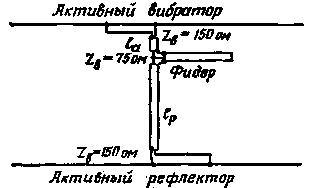
First of all, it should be noted that the operation of the antenna is greatly influenced by the performance of the phase-shifting lines. Constructive calculation of the phase-shifting lines (see figure) can be performed with sufficient accuracy as follows. The geometrical length of the line is determined (with some margin for sealing cable ends) from the expression

The electrical length of the line is

The electrical length of the line segment

The electrical length of the line segment

The geometric length of the segments is defined as

All formulas: l - the length of the wave in meters; l R,l R - geometric length in centimeters; Lэ,lэ - the electrical length, in degrees;
x - elongation of the cable, depending on the material to its inner insulation (for common cables domestic production with polyethylene insulation x=1,52),
In the antenna for 14 MHz band designed line cable RK-75-9-13 had lэ=35, lp=260 & L=295 see One degree electrical length of the line corresponds to 5 cm geometric length, which allowed to perform line and it cuts with accuracy not worse than ±1°.
The line can be made of a cable of the same type as that used to power the antenna. Despite the fact that at the point of connection to line power cable input resistance is two times less than the input impedance of each antenna element, a small (compared to the length of the working wave) cable length phase-shifting line with mismatched impedance does not increase the value of the CWS.
Built and tested on the radio UA4LK antenna showed good results while links to various distances. The gain was 5 to 6 dB power, width of anterior lobe of radiation in the 0.7 to about 60°. Thanks to more effective action of the reflector has managed to greatly reduce interference from stations (including local) that are outside the front lobe of radiation. The effect of this suppression is evaluated at the hearing in the range of 20-30 dB.
Author: F. Kozlov (UA4LK), Ulyanovsk; Publication: N. Bolshakov, rf.atnn.ru






